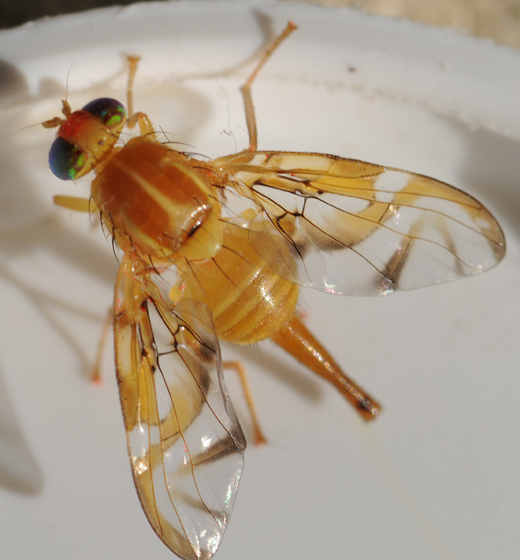 |
| Mexican fruit fly, Anastrepha ludens (Loew). Image by by Hartmut Wisch. Iowa State University: BugGuide |
In what was an inevitable outcome of massive international
trade, a male Mexican fruit fly, Anastrepha ludens (Loew)
was intercepted in Maryland for the first time at the Baltimore-Washington
International Airport in September.[1]
The United States was once insulated from novel species accidental
introductions by cast oceans and particular predictable long term weather
patterns. Unless intentionally introduced and cultivated until established,
species did not simply wander in. Today, the size and scope of international
trade provides the perfect pathway for repeated unintentional introductions of
non-indigenous species a few of which get their green cards quickly and begin
to proliferate causing harm to commerce and to ecosystems. We call these few
invasive species.
The skill and proficiency of USDA APHIS and ARS scientists
and professionals collaborating with U.S.
Customs and Border Protection work to prevent the introduction of unwanted,
unknown and potentially harmful organisms. Finding one fruit fly at one airport
should give us pause to consider the likelihood that a Mrs. Anastrepha managed
to escape detection.
The Mexican fruit fly is at home in Mexico and much of
Central America as far south as Costa Rica. It has migrated into the cultivated
citrus sections of the west coast of Mexico and northward toward Texas, Arizona
and California.
In January 2012, the
USDA-APHIS announced that the Mexican fruit fly was eradicated from the last
county in Texas in which it had been present.[2] However
only three months later on March 9, 2012, the Animal and Plant Health
Inspection Service (APHIS) established a Mexican fruit fly (Mexfly) quarantine
area in the San Benito area of Cameron County, Texas applying restrictions on
the interstate movement of regulated articles from this area in order to
prevent the spread of Mexfly to non-infested areas of the United States.[3]
The really big question is why you care. Out visitor reduces
the amount of all varieties of citrus that you can buy, lemons and sour limes
excepted. The Mexican fruit fly loves grapefruit most of all but is comfortable
competing with you for oranges, white sapote and mango. Closer to home in
Maryland are pears, peaches and apples are eagerly sought after by our new acquaintance. And if this were not enough, A. ludens has been shown, according to
the University
of Florida's Featured Creatures website,
to sample avocado, cherimoya, custard apple, mamey, pomegranate, quince, rose
apple, yellow chapote, cacti, figs, bananas, tomatoes, peppers, squash and
beans.
Invasive species do matter, and they do cost. More than a
decade ago invasive species were estimated to impact the United States to the
tune of 130 billion dollars a year.[4] Do you think this cost has gone down, or given
the reduction in the scope and funding of the federal government and the
increase in global trade, gone down?
[1]
USDA APHIS handout to the Maryland Invasive Species Council November 2012.
[2] Featured Creatures provides in-depth
profiles of insects, nematodes, arachnids and other organisms. The site is a
cooperative venture of the University of Florida's Entomology and Nematology
Department and the Florida Department of Agriculture and Consumer Services'
Division of Plant Industry. [accessed November 23, 2012]http://entnemdept.ufl.edu/creatures/fruit/tropical/mexican_fruit_fly.htm
[3]
From February 27 to March 7,
2012, seven unmated and one mated adult female Mexflies were detected in
grapefruit and orange trees located in a commercial grove in the San Benito
area of Cameron County, Texas. APHIS, in cooperation with the Texas Department
of Agriculture (TDA), is responding to the detection. .. The establishment of this quarantine
area is posted on the following APHIS website, which contains a description of
all the current Federal fruit fly quarantine areas: http://www.aphis.usda.gov/plant_health/plant_pest_info/fruit_flies/index.shtml [accessed November 23, 2012] http://www.pestalert.org/oprDetail.cfm?oprID=515
[4] Economic
and environmental threats of alien plant, animal, and microbe invasions (2001)
David Pimentel, S. McNair, J. Janecka, J. Wightman, C.
Simmonds, C. O’Connell, E. Wong, L. Russel, J. Zern, T. Aquino, T. Tsomondo [ACCESSED nOVEMBER 23, 2012] http://www.invasivespeciesinfo.gov/economic/us.shtml#.UK9-O4c8CSo
No comments:
Post a Comment